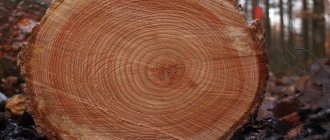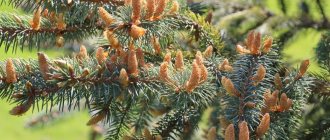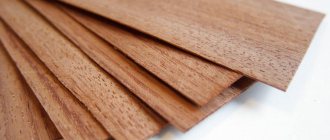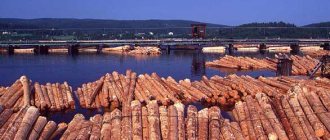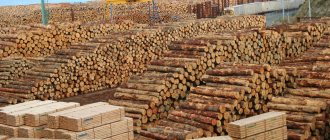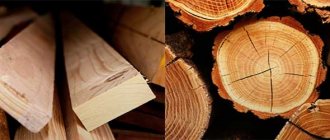Pine wood is one of the most common materials for construction, furniture making, etc. There are several dozen varieties of pine. They all have their own distinctive characteristics, which they acquire depending on where the tree grew. Scots pine is common in our country. This wood must be used for construction or decoration, furniture production, etc., taking into account its characteristics.
Characteristics and composition of wood
The pine tree species grown in the northern regions are different from their counterparts that grew in the south. It is the wood of such species that is used in construction work. The physical and mechanical properties of these trees meet the requirements for wooden building materials. They have increased strength and resistance to pests. The cost of pine materials is lower than other types of wood.
Pine trunks, like all coniferous trees, are straighter and slimmer than deciduous trees; they have fewer defects. Pine wood lends itself well to processing and finishing. Its density and hardness indicators are average. Strength is high. It can be glued. All these qualities are due to the structural features of coniferous wood.
The core is located in the middle of the trunk. It has a thickness of 0.1 - 0.4 mm. When cut, it has the shape of an not quite regular circle. This layer consists of parenchyma cells with thin lignified walls. The composition of pine wood also includes pith rays, tracheids, and resin ducts. The fibers are even. Vessels located along the trunk ensure the delivery of moisture from the root system to the crown.
The core of a freshly cut Scots pine trunk differs from the sapwood in having a lower moisture concentration.
Its function is predominantly mechanical: it ensures the stability of the trunk. Tree rings are clearly visible. Later layers are darker than earlier ones. Characteristics of pine wood
| Characteristic | Meaning |
| Density | 520 kg/m3 |
| Brinell hardness | 2.5 kgf/mm2 |
| Janka hardness ft | 380 -1240 lbf |
Juniper
Juniper wood
Juniper (Juniperus) (see link). Most junipers are shrubs, but in southern Karelia there are also tree-like forms up to 12 m high and 16 cm in diameter. The only representative of the cypress family (Cupressaceae) in the northern forests. It is found both in dry pine forests on sandy soil and in spruce forests that are excessively moist and even swampy.
It grows slowly, is frost-resistant, and light-loving. Does not tolerate smoke and soot well. Distributed in the northern and middle parts of the European territory of Russia, in Western Siberia, and enters Eastern Siberia.
Juniper is a sound species. Near the bark there is a narrow light yellow strip of sapwood, forming a wavy ring of irregular shape. Inside the ring is red-brown core wood. Over time, the sapwood turns dark yellow with a greenish tint, and the heartwood acquires beautiful olive-blue hues. On the end section of a juniper, the annual layers are clearly distinguished. The texture is beautiful, with a reddish tint, sometimes striped or wavy. Particularly impressive in cross section.
Juniper, unlike other conifers, does not have resin passages, so it easily accepts various dyes and is easily polished. Strong, heavy and dense juniper wood can be easily processed with a variety of cutting tools. The cuts are clean and glossy.
Juniper wood has slight shrinkage and practically does not swell when wet. It can be successfully used for very thin flat-relief and volumetric carvings; small decorative items, canes, sculptures, small crafts and toys are made from it. End cuts are used in inlay.
Volumetric weight at standard humidity (12%) is about 920 kg/m3.
Differences from other conifers
How can you distinguish pine wood from other conifers, in particular from spruce? Pine contains significantly fewer knots. It has a striped texture. The annual rings are clearly visible in the sections. The medullary rays are invisible. It is characterized by high density and strength. However, it is quite soft and light wood. It is distinguished by its increased resin content, making it resistant to decay and the effects of fungi, parasites, as well as precipitation and other atmospheric phenomena.
Pine wood has high-tech properties and is easy to process. Due to this, it is used in production more often than other coniferous species. It is used to make furniture, musical instruments, containers, and is used in construction and finishing work.
Larch
Larch wood
Larch (Larix) (see link) is a coniferous tree from the genus Larix of the pine family (Pinaceae). It is durable, lives up to 900 years or more and reaches a height of 45 m with a trunk diameter of 80–180 cm. It is found in nature in the east and northeast of the European part of Russia, in the Urals, in Western and Eastern Siberia, in the Altai and Sayan Mountains.
This is the most common breed in Russia. It makes up 2/5 of the forested area. The breed is sound with resin passages. Has a beautiful texture. The annual layers are clearly visible in all sections. The sapwood is narrow, white with a slight brownish tint. The kernel is reddish-brown, sharply different from the sapwood. The medullary rays are not visible, the resin ducts are small and few in number.
The wood contains essential oils (pinene), has a fairly strong pleasant odor and includes bioflavonoids and phytoncides - microscopic volatile substances that evaporate during the entire period of use and have a positive effect on health, preventing colds and viral diseases.
Larch wood is an excellent building material because it has high density and strength, it has few knots, and it belongs to the group of biostable (it does not rot or be damaged by fungi). Larch is strong, elastic, hard, durable, and resists rot and insects well. Long-term exposure to water leads to an increase in the hardness of larch, which is why it was used for the construction of bridges and piers. All Venetian buildings stand on larch stilts.
Larch wood easily cracks during the drying process and splits. It is more difficult to process on a machine than other rocks (due to its high density and resin content) . Resinous substances make planing, polishing and varnishing somewhat difficult, but in general the wood can be painted and polished successfully after proper filling.
The best wooden buildings are built from this type of wood. It is used for carpentry, window frames and flooring.
This is interesting
The parquet flooring of the Ostankino Palace of Counts Sheremetyev and the window frames of the Winter Palace prove that larch can serve for many years.
Volumetric weight at standard humidity (12%) – 650–800 kg/m3.
Texture
A freshly cut trunk has a pinkish core. The color is determined by the location of the tree, its species, age, and structural features. Pine wood has a uniform structure, is characterized by low elasticity and high strength. The fibers are straight, this applies to almost all types of pine. According to its texture, experts classify it as a medium-coarse rock.
Mechanical properties
Pine is a medium-density and medium-hard wood species. And its strength indicator is high. When compressed along the fibers, the tensile strength is about 440 g/cm2. It doesn't bend well. The ability to resist splitting is low. Moisture and breathability are high. However, different breeds have different mechanical properties. Northern pine is considered the best. Its annual rings are located at a minimum distance from each other - no more than 2 mm, so it is less loose and more durable. Her shrinkage is lower. Northern pine is less susceptible to cracking.
Physical properties of pine
Pine is a tall tree with a straight slender trunk 30-50 m high and 70-100 cm in diameter. Some specimens reach 70 m in height. This is a fairly fast-growing tree; in a year it grows up to 1 m. However, pine lives for 300-400 years. The color of pine wood varies from white-yellow to orange-brown. It depends on the species, location and age of the tree. During long-term storage, wood darkens.
The sapwood is lighter in color than the heartwood. The wood has resin ducts. The humidity of a growing tree is about 33% in the core, and 110-115% in the sapwood. The upper part of the tree has a higher sapwood moisture content. In the core, the humidity of the upper and lower parts is the same. The trunk of a freshly cut pine tree has a moisture content of approximately 85%.
The high moisture permeability of pine wood allows it to be quickly and easily impregnated with protective compounds - antiseptics, etc. These properties of pine wood are taken into account when using it in construction. An important characteristic is also the low tendency to warping and cracking during the drying process.
Tiss
Yew wood
Yew (Taxus) (see link) is a very ancient breed. An evergreen coniferous tree from the yew family (Taxaceae), about 20 m high (the highest known height is 27 m), trunk thickness is 1 m. The crown is wide-spreading, very dense. The needles are soft, flat, dark green, located on the branches in two rows.
Yew berry and yew pointed
Yew berry (Taxus baccata) grows in the mountains of the Caucasus and Crimea. It is often called European because it is found in almost all of Western Europe. The habitat of yew berry also covers areas of Western Belarus (Belovezhskaya Pushcha), Western Ukraine (Bukovina), Southern Crimea, the Caucasus, as well as the Azores Islands, the mountains of Algeria, Asia Minor and Syria.
The second species is the pointed yew, or Far Eastern yew (Taxus cuspidata) , common in the Primorsky Territory and Sakhalin. The wood is hard and heavy, almost impossible to rot. Sometimes on the yew there are nodules, densely covered with very short shoots with pale needles.
The lifespan of yew berry is up to 1500 years, and sometimes up to 3-4 thousand years. The sapwood and heartwood of yew wood are very different from each other. The color of the core ranges from red-brown to orange-brown.
A characteristic feature of yew wood is tiny black dots, ideally grouped on the surface. The annual layers are sinuous and look like wide, dark rings.
Yew is easy to dry and process. Its wood is toxic and must therefore be processed with extreme care. It has a beautiful texture and is used for making furniture and as a finishing material, it is very durable and is used for various carpentry projects.
Volumetric weight at standard humidity (12%) is about 620 kg/m3.
______________________________________________________
Wood protection
Wood is a very popular building material: it is light, environmentally friendly, has low thermal conductivity and is quite durable. The last advantage of this material can be enhanced many times over if it is properly protected.
Processing Features
Pine wood is not afraid of fungi, insect pests, or putrefactive damage due to its increased resin content. According to this indicator, pine varieties are divided into tar (with a high resin content) and dry chips or dutitsa (low resin content). Resinous pine is not recommended for use in carpentry because the resin makes sawing and planing difficult and sticks to tools. When heated, the varnish coating may rise. If you still need to process pine wood, it must be deresined. For this purpose, solvents, acetone, gasoline, alkali solutions, and alcoholic substances are used.
Dry chips are not suitable for products intended for increased loads. It lends itself well to cutting, planing and painting. To process dry wood chips, both mechanical and hand carpentry tools are used - a jointer, a plane, etc. Pine wood is easily planed along the grain, but not across it, so it is recommended to use sawing for this. Dried pine chips sand and glue well. Fastening materials (screws, nails) are held satisfactorily.
The resin content of pine increases the susceptibility of a building to fire. For this reason, it is necessary to treat the material with protective compounds. Due to the increased moisture permeability of pine wood, a high consumption of finishing materials is required. When painting the surface of pine lumber, spotting may occur. To avoid this effect, the board must be dried. It is also necessary to use high-quality materials for coating.
Advantages of pine houses
Below are the advantages of houses made of pine timber. Pine log houses require special attention and their advantages and disadvantages are outlined in the following article.
- Pine is a lightweight material, so when building a house from this material, you can save on the foundation. There is no need to build a massive, heavy and expensive foundation.
- A house made of pine, due to its low density, allows air to pass through well and releases internal moisture. The effect of a breathing house is created.
pine houses have an aesthetic appearance
- Aesthetic appearance both outside and inside the house. The pine walls themselves are part of the interior and create a special atmosphere.
- Low cost compared to other breeds. Pine timber will cost less than other types of lumber.
- Unique microclimate inside the house. When the temperature changes, pine emits a pleasant pine smell and substances that have a bactericidal effect. The effects of substances released by pine, like other conifers, have a positive effect on the human nervous system.
There is a unique microclimate inside the pine house
Areas of application of pine wood
Pine is the most popular lumber among all coniferous species. The scope of its application in the national economy is extensive. It is distinguished by its reliability and low cost compared to deciduous wood - oak, ash, etc. It is actively used in construction for the construction of residential buildings, bathhouses, and outbuildings. The tall and straight pine trunk has few knots. Therefore, it is suitable for the production of rounded logs and beams with a small amount of waste.
Resistance to rotting and damage by parasites distinguishes it favorably from spruce. However, for the construction and interior decoration of baths, it is preferable to use spruce, which has less resin.
The strength of pine wood allows it to be used to make load-bearing structures of buildings, beams, rafters, floors, frames, wooden piles, window frames, etc. The low thermal conductivity of pine wood ensures maintaining a comfortable temperature in the room. Pine buildings also have a sufficient level of sound insulation, and no additional work is required for this purpose. Pine boards are also used for interior finishing work, flooring, etc.
Pine lumber is used in the production of furniture. Frames are mainly made from them, which are covered with veneer of other types of wood. The low density of this material allows you to decorate furniture with mosaics and carved patterns. Such furniture is reliable and meets environmental requirements.
Pine is used in shipbuilding, chemical and paper industries, railway construction, etc. Pine needles are raw materials for the production of medicines and biological additives.
Norway spruce
Spruce wood
Norway spruce (Picea abies) (see link) is an evergreen coniferous tree of the pine family (Pinaceae), 20–50 m high, with a cone-shaped crown and flaky brownish-gray bark. Lives up to 300 years. The trunk is round and straight.
It grows in damp places, on rich loamy soils, rising into the mountains to a height of up to 1800 m above sea level (forms pure spruce forests). Widely distributed in Central, Northern and Northeastern Europe above 69°N latitude, north of the Pyrenees to Russia and Scandinavia.
Other species: Ayan spruce (Picea ajanensis), Korean spruce (Picea koraiensis), Siberian spruce (Picea obovata).
Spruce is a coreless mature wood species. The wood is white with a yellowish tint, low resinous. Resistant to cracking. The annual layers are clearly visible. In terms of strength, density and resistance to rotting, spruce is in no way inferior to pine. However, it is more difficult to process compared to pine due to the large number of knots in it and their increased hardness.
Spruce is very susceptible to insect damage.
Spruce wood is characterized by the highest value of the acoustic constant, which characterizes the emission of sound. Tannins are obtained from spruce bark. The wood is soft, easy to process, polish, and varnish. It is used in the same areas as pine, but especially in the pulp and paper industry and in the production of musical instruments.
Volumetric weight at standard humidity (12%) is about 450 kg/m3.
